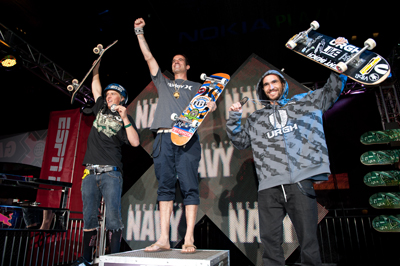To the Edge: Producing and Broadcasting Summer X Games 2011
As a hybrid live/broadcast event, the X Games franchise is the closest thing we have to the Olympics, only better, because ESPN has near-complete control over the events and seems to enjoy taking the "extreme" philosophy at the heart of the games to the limit.
Managing The Back And Forth
Making sure that happens takes a lot of work and connectivity. Working from his Avid Profile console located in the trailer of OSA International, the systems integrator that installed all the temporary audio and video systems for the Games, in an alley crowded with remote broadcast and satellite uplink trucks, Johnson also routes intercom and sports-com feeds, 4-wire connections between the producer/director teams at each venue and the ESPN producers and directors. That interaction underscores how important manipulating the energy of the live event is for the broadcast show.
"The [broadcast] director at one [ESPN] location will let the [live-event] director at another location know that they're going to be sending them to air in 15 seconds, so they'll ask the [live] announcers at that event to get he crowd pumped up by telling them through the PA system, ‘Hey, you're all gonna be on television in 15 seconds! Let's hear it!'" Johnson explains, mimicking the warm-up comedians that late-night talk show hosts use to pump up their crowds right before air time.
Johnson's crew arrived on site on July 22 and had five days to put the entire network together on a campus of seven venues, five of which didn't exist on July 21. "Our directors in the field are communicating with the broadcast directors and they're all tied together though the intercom. They can toss signal back and forth from venue to venue and to air."
Some of the PA systems are small, used to cover play areas for children at the games. Others, such as the one at Lot 7, where the Rally Cars and Big Air were played and that used a system comprised of six JBL 4888 enclosures, and two 4882 subs, are closer to what you'd find at a sizable outdoor music concert. At midsized venues, such as the Park Street skate park with its bleacher seating, is covered by a JBL VRX system, with 30 enclosures attached three or four per pole. Indoor venues, such as the Staples Center, where the Super Moto X was, use the venue's existing PA system augmented with five pole-mounted JBL SRX712M enclosures as additional fill speakers. The existing venues also use their in-place audio consoles, such as the Soundcraft Vi6s at the Nokia Theater and Staples Center; large outdoor events had FOH consoles including Avid Venue and Profile consoles brought in, while smaller and mid-sized ones used Yamaha 2000 and O2R mixers. Signal from these consoles also fed a new wrinkle for the X Games this year: a dedicated Facebook streaming channel, which also was used on ESPN's own streaming site, powered by the NewTek TriCaster and recorded to hard dives.
Another element that sets the sound of Summer X Games apart is that competitors are allowed to choose their own music to be played during their time in the spotlight. Each one fills out a form ahead of time and a department within ESPN, which owns the X Games, will handle music clearances.
Audio Sync
"The show is constantly moving, and we're able to show the audience at one event site real-time or replay video and audio of what's going on at another in between the competitions they're watching," says Johnson, who agrees that it comes across as channel-surfing on huge video screens. "People may have bought tickets to only one or two events but the get to see snippets of what's happening at other venues [via video], so they're getting a very full experience."
As a result, one of Johnson's biggest challenges is achieving good lip sync between the audio and video from so many separate signal sources for the video at the venues. The conversions of the video signals in the Stagetec Nexus routers from analog to digital usually induce a three-frame delay that Johnson offsets the audio accordingly to in milliseconds. However, that frame offset would also vary based on the distance the signals had to travel from venue to matrix to broadcast.
"Some venues that were 1,500 to 2,000 feet away would add another frame or so, maybe as many as three more frames," he estimates. "The Rally Cars event was far enough away to require a total of eight frames of offset, and that created another issue. We have to adjust the audio delays from event to event and even camera to camera. We're doing it by feel but usually by the second day we have a pretty good idea what the offsets need to be for each signal. We get into a groove."

The Big X as backdrop